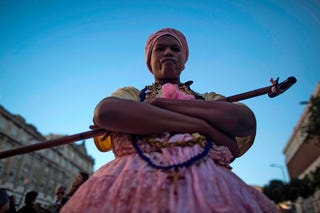
We know that the most black people in the Western Hemisphere— and outside of Africa—live in the country of Brazil, because of slavery.
But did you know that nearly one million Africans came through a recently discovered site in Rio de Janeiro, Valongo Wharf, also known as “Slave Wharf”?
The area has recently been made declared a UNESCO World Heritage site, in memory of those made the horrific trek from Africa.
According to the Independent, more than 900,000 Africans were held at Slave’s Wharf before being sold on to markets throughout the country. Valongo Wharf operated for three centuries and became the biggest entry point for African slaves in Brazil. The BBC reports:
After the long journey across the Atlantic, emaciated African captives were kept in the wharf area to recover and gain weight, so they could be sold on at slave markets. Many did not survive and were buried at a nearby cemetery.
…
Some four million slaves arrived to work in plantations and domestic workers from the 17th to the end of the 19th century. That amounts to 40 percent of slaves taken to the Americas.
After Brazil was declared a republic in 1889, the Valongo site was used as a landfill and eventually a square was built over the wharf. Until recently, it was buried underneath a square, a street and a car park.
Many Brazilians were unaware of the area’s history until the 2016 Olympic games, when a mass grave with skulls and bones was uncovered. Archaeologists estimate that more than 6,000 Africans who died on the transatlantic passage were buried at the site, with 30,000 buried in the surrounding areas.
UNESCO said the site was as important as Hiroshima and Auschwitz “to make us remember those parts of the history of humanity that must not be forgotten.”
Read more at the Independent and the BBC.



